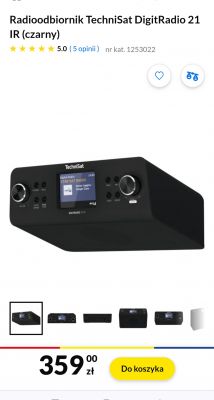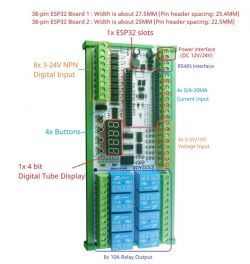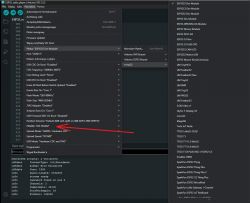Hello everyone,
for a long time I've wanted to make something cool that could be used basically every day - i.e. a useful computer desk accessory. So I came up with an internet radio with a file player on a cool OLED display. As I don't program microcontrollers every day, there are sometimes small errors in the code. The project will still be developed and the code fixed / optimised. Initially I built everything on a contact board, but I was constrained by the fact that the ESP32 module just happened to have one side of the pins unused, and I didn't want to keep messing it up with soldering, so I designed a new board - hereafter referred to as a prototype board, because everything on it is still on goldpin bases and sockets. Unfortunately I missed one mistake, downloading the ESP32-S3-WROOM-1 pad from the EasyEDA base it turned out that there was a difference in pin spacing across the width of the module. There may have been different versions, but in the end, after slightly bending the pins, I managed to get it to fit on the base board. I have posted all the actual code, PCB view, gerber files for PCB fabrication and pictures on my github. I encourage you to make yourself such a kit to start with on a contactor, the learning and fun of an interesting device is priceless. Feel free to comment.
https://github.com/sarunia/ESP32_radio_player
Following the topic: on the next pages you will find a description of my v2 version of the radio with file player, which was based on v1 version. v2 version was equipped with a higher resolution display and more refined in terms of source code.
I've included a link to my github below, where you can find the project documentation and all the source code:
https://github.com/sarunia/ESP32_radio_player_v2
edit. XI.2025 - then appeared my new version v3 with a colour screen enriched with a weatherman, calendar sheet, news from RSS channel Polsat News Polska, version v3 is deprived of local control, full operation from remote control, you will find all data on my repo:
https://github.com/sarunia/ESP32_internet_radio_v3
Based on my project a fellow forum member @robgold also made his own version of the radio:
https://github.com/dzikakuna/ESP32_radio_evo3
the radio stations are downloaded from github, there are switched banks - max 100 stations each, then you switch each one back and forth:
https://github.com/sarunia/ESP32_stream
Costs:
OLED display 2.42" 128x64px white £60
ESP32-S3-WROOM-1-N16R8 WiFi , Xtensa LX7 48zł
PCM5102A DAC module 30zł
enclosure, I didn't want the usual black one, unfortunately this one was also expensive GAINTA G748 56zł
mB102 power supply module for contact boards or another similar one, because there are plenty of them everywhere, mine was for 8zł
2 rotary encoders with pushbutton, each about 8zl
4 switches (two PS11BBK and two PS11BBU) total about 16zl
2 gold plated RCA sockets (black marker CC-222B and red marker CC-222R) together for about 20PLN
pCB made in Poland quite expensive, 1 piece cost me 130zl including shipping
Currently this is what the file playback and radio looks like:

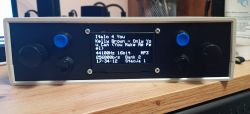
And this is how it looked during earlier works:
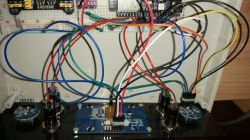
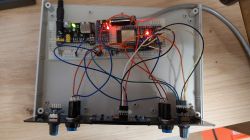
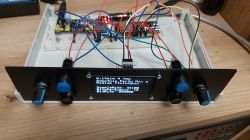
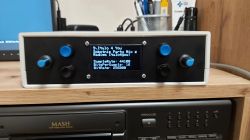

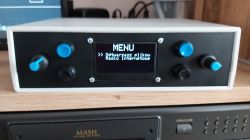
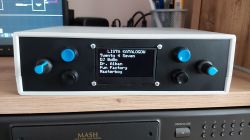
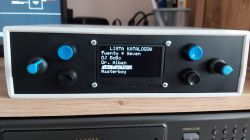



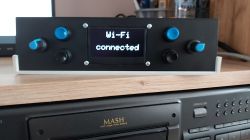
Note that the following attachments are for the v1 version of the radio.
for a long time I've wanted to make something cool that could be used basically every day - i.e. a useful computer desk accessory. So I came up with an internet radio with a file player on a cool OLED display. As I don't program microcontrollers every day, there are sometimes small errors in the code. The project will still be developed and the code fixed / optimised. Initially I built everything on a contact board, but I was constrained by the fact that the ESP32 module just happened to have one side of the pins unused, and I didn't want to keep messing it up with soldering, so I designed a new board - hereafter referred to as a prototype board, because everything on it is still on goldpin bases and sockets. Unfortunately I missed one mistake, downloading the ESP32-S3-WROOM-1 pad from the EasyEDA base it turned out that there was a difference in pin spacing across the width of the module. There may have been different versions, but in the end, after slightly bending the pins, I managed to get it to fit on the base board. I have posted all the actual code, PCB view, gerber files for PCB fabrication and pictures on my github. I encourage you to make yourself such a kit to start with on a contactor, the learning and fun of an interesting device is priceless. Feel free to comment.
https://github.com/sarunia/ESP32_radio_player
Following the topic: on the next pages you will find a description of my v2 version of the radio with file player, which was based on v1 version. v2 version was equipped with a higher resolution display and more refined in terms of source code.
I've included a link to my github below, where you can find the project documentation and all the source code:
https://github.com/sarunia/ESP32_radio_player_v2
edit. XI.2025 - then appeared my new version v3 with a colour screen enriched with a weatherman, calendar sheet, news from RSS channel Polsat News Polska, version v3 is deprived of local control, full operation from remote control, you will find all data on my repo:
https://github.com/sarunia/ESP32_internet_radio_v3
Based on my project a fellow forum member @robgold also made his own version of the radio:
https://github.com/dzikakuna/ESP32_radio_evo3
the radio stations are downloaded from github, there are switched banks - max 100 stations each, then you switch each one back and forth:
https://github.com/sarunia/ESP32_stream
Costs:
OLED display 2.42" 128x64px white £60
ESP32-S3-WROOM-1-N16R8 WiFi , Xtensa LX7 48zł
PCM5102A DAC module 30zł
enclosure, I didn't want the usual black one, unfortunately this one was also expensive GAINTA G748 56zł
mB102 power supply module for contact boards or another similar one, because there are plenty of them everywhere, mine was for 8zł
2 rotary encoders with pushbutton, each about 8zl
4 switches (two PS11BBK and two PS11BBU) total about 16zl
2 gold plated RCA sockets (black marker CC-222B and red marker CC-222R) together for about 20PLN
pCB made in Poland quite expensive, 1 piece cost me 130zl including shipping
Currently this is what the file playback and radio looks like:


And this is how it looked during earlier works:












Note that the following attachments are for the v1 version of the radio.
Cool? Ranking DIY







